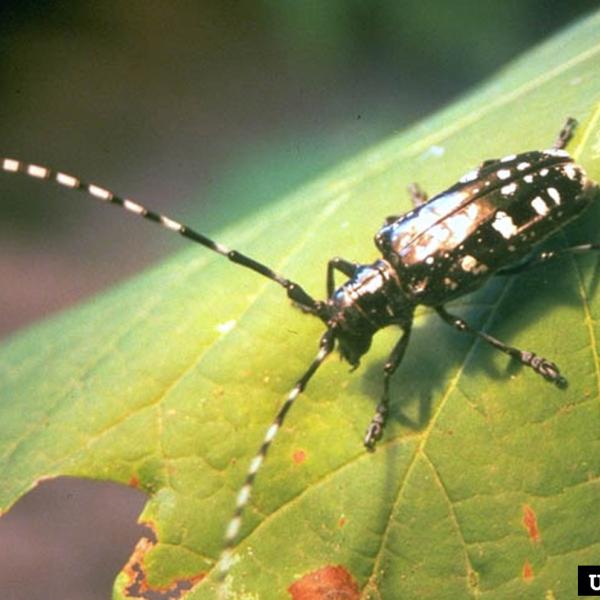
News Source
The Asian longhorned beetle (Anoplophora glabripennis) has been an invasive pest in North America since 1996, when it arrived from China and Korea, probably through infested wood-packing material. Today, it’s been detected in the northeast United States, Canada, and Europe and at nearly every port in the U.S. Since its arrival, the beetle has caused significant economic and ecological impacts.
Efforts to eradicate the beetle involve removing and destroying wood “host material” on which it feeds and applying preventive insecticides in designated quarantine areas. These efforts have helped eradicate the beetle in New York, cities in New Jersey, Chicago, and Boston. However, even quarantined areas still report beetles, according to the United States Department of Agriculture. And new beetle infestations in less urban areas like Worcester, Massachusetts, and Bethel, Ohio, which are adjacent to heavily wooded areas, have raised questions on how a quarantine can be enforced and what extent of quarantine would stop the beetle’s progress.
A research team led by Vanessa Lopez, postdoctoral researcher at Xavier University at the time of the study (and now with the US Forest Service’s Forest Health Assessment and Applied Sciences Team), arrived at more accurate quarantine borders by studying flight, age, and nutritional health of the Asian longhorned beetle. Their work, published Monday in the Journal of Economic Entomology, found that older beetles that fed had the longest flight performance, while mating status, body size, and sex didn’t have a significant effect on flight distance. The longer the flight distance, the researchers reasoned, the greater the quarantine area needed to be.
Previous studies have used tracking methods based on insect dispersal in the field, which can’t effectively determine long-distance flight potential. Lopez’ team used computerized flight mills, which tether an insect to a rotating laboratory apparatus that measures the insect’s speed, distance and flight periodicity as it flies in circles. Each flight mill was connected to a laptop computer for data capture and analysis. The mill, while not in a field setting, can carefully control physiological effects on flight, such as eating, age, size, and mating status.
In their experiments, Lopez’ team measured beetles that were starved or fed, virgin or mated, and young or old. The researchers found that the distance flown by adult beetles was influenced most by being fed. Older beetles (more than five days past emergence from pupa stage) flew further than younger beetles. Also, older, well-fed adults flew farther than older, starved adults. Older, well-fed adults also made more attempts to fly.
Significantly, the beetles could fly up to 8.5 miles, well above the average flight distance of 1.4 miles (2.3 kilometers).
“In North America, [Asian longhorned beetle] is a quarantine pest,” wrote the study authors. “Information on the maximum dispersal potential of this beetle could benefit current eradication efforts in Massachusetts and Ohio by helping by refine quarantine zones and surveying protocols.”
Anoplophora glabripennis is one of more than 450 species of invasive forest insects now living in the United States. Its larvae hatch in trees and begin feeding on tissue just under the bark (that usually provides water and nutrients to support growth), and later begin feeding on the woody core of the tree, eventually killing it. After emergence from pupal stage, the adults chew their ways out of the tree and begin mating. About 12 types of trees are targeted by A. glabripennis, including ash, birch, elm, golden raintree, sycamore, maple, horse chestnut/buckeye, katsura, mimosa, mountain ash, and willow. Economically, it has threatened several industries, in particular maple syrup production in the US Northeast.
Article by Andrew Porterfield
Photo credit: Kenneth R. Law, USDA APHIS PPQ, Bugwood.org